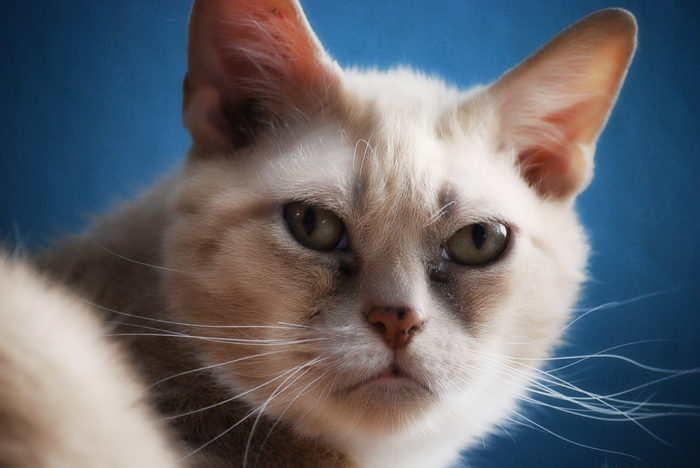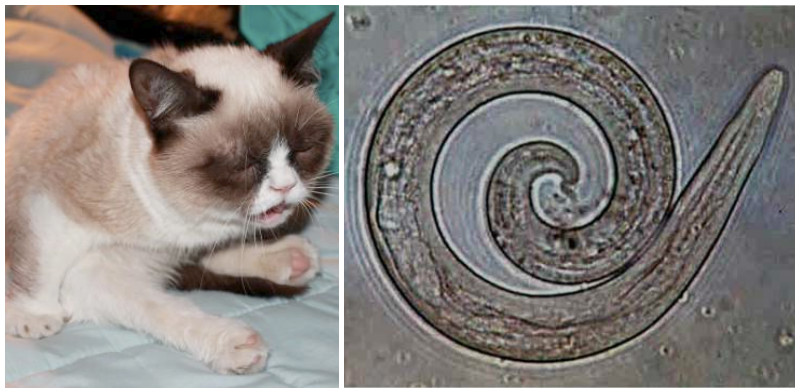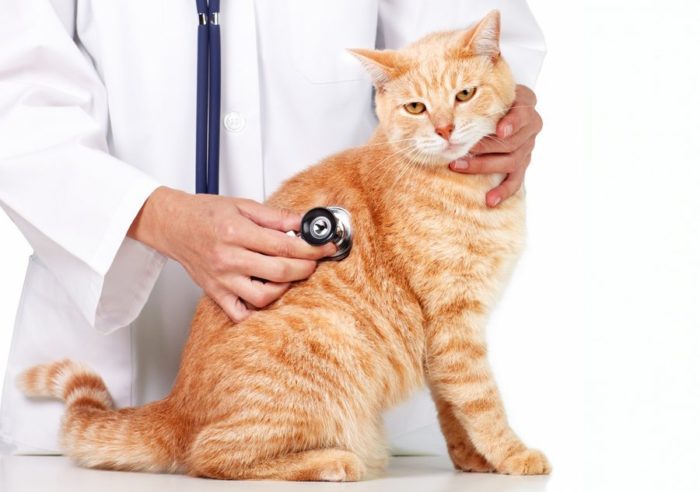Worms are very often especially in cats, if at least occasionally they walk along the street. Most often, veterinarians have to deal with fairly “trivial” cases, including infection with toxocaram and toxoascarides. But sometimes there is “exotic”, among which are pulmonary worms in cats.
Contents
General information
Pulmonary helminths live, as is easy to guess, directly in the respiratory tract of diseased animals. In the “wild nature” spread three types: Aelurostrongylus abstrusus, Paragonimus kellicotti and Capillaria aerophilia.
All of them need for development intermediate owners, without the involvement of which the infection of the cat can not occur. For example, the parasite Aelurostrongylus requires land snails or slugs. Many veterinary reference books say that infection occurs when they are eaten by cats. That’s just in practice, it’s pretty hard to find a cat that would willingly slug slugs.
The situation is that animals become infected by eating small rodents and birds, which are more common eaters of mollusks. In general, if your cat even occasionally walks on the street and hunts on someone, it can easily get pulmonary worms. By the way, the raccoon helminths are almost completely affected by raccoons: they adore eating crayfish, slugs and snails, which makes the “saturation” of their body parasites out of reach.
Note that the infection is most severe in cats under the age of two. It is their worm infestation that is most “tense” because of the huge number of parasites in the organs of the respiratory system. Symptoms depend on the specific type of parasite, the reaction of the animal’s body and other factors. Sometimes the owners can not guess that there is something wrong with their pet, whereas in other cases the cat starts to cough and sneeze constantly, it develops an apathetic state, the animal refuses to feed.
Characteristics of parasites
Note that sometimes the term “pulmonary helminths” refers to the presence of migrating larvae of parasitic nematodes in a pet. Yes, the clinical picture is very similar, but it is somewhat different. Pulmonary worms are not short-term “guests” of cat’s lungs. They live and reproduce there constantly, throughout the life cycle. And this cycle, by the way, can be very difficult, since it involves several intermediate hosts.
And now it is necessary to briefly describe the characteristics of those parasites, the list of which was given above. Here are the main “lungs”, found not only on the territory of our country, but all over the world:
Aelurostrongylus abstrusus. It affects, mainly, cats. The most “versatile” parasite in all senses. First, its intermediate hosts may be mollusks, reptiles, amphibians, mammals and even birds. Secondly, this worm is spread all over the world.
Paragonimus kellicotti. Most often affects dogs, but described a number of cases when the cats were sick. Intermediate hosts are freshwater mollusks and crabs. An additional (and final also) host may be a raccoon or a raccoon dog. With the latter, by the way, the parasite got to the territory of our country, today the cases of infection are quite often found in the Far East.
Capillaria aerophilia. The most “rectilinear” worm. To infect a cat it is enough to swallow an egg of a parasite. It is believed that this species “trades” only in North America.
Symptoms
The main clinical sign is a frequent cough. Of course, it can not be called a specific feature. A similar “clinic” can be observed in the following diseases, one way or another affecting the respiratory and cardiovascular systems:
- Obstruction of the respiratory tract (foreign body, tumor).
- Asthma.
- Bronchitis, pneumonia.
- Other respiratory tract infections. They develop very often and in the presence of “lungs,” because of the worms, the state of the body’s defense systems deteriorates substantially.
- Infection with a cardiac helminth.
- Diseases of the heart and blood vessels.
- Allergic diseases of the lungs.
- Pulmonary granulomatosis.
- Pulmonary neoplasia (lung cancer).
Thus, the main task of the veterinarian is to establish the correct diagnosis with the simultaneous elimination of those diseases that could lead to a similar outcome. This is done on the basis of data obtained as a result of complex diagnostic studies.
Diagnostics
As we have already mentioned, it is physically impossible to put the diagnosis without corresponding analyzes. These may include:
- Complete medical history and medical examination. The owner should know when, how and after which his pet began to go in attacks of a strong cough.
- Chest X-ray. It is needed to exclude other causes of coughing. Some pulmonary worms lead to characteristic suggestive changes in the lungs.
- Microscopic examination of feces for the presence of eggs of helminths or their larvae. Note that pulmonary worms may not be detected in this way. This analysis, rather, is done to identify the possible presence of other types of intestinal parasites.
A check for the presence of cardiac helminths, including serological tests of blood plasma, is mandatory. If parasites of this species in the animal is, in the blood inevitably (but not immediately) there are specific antibodies.
Other methods
Additionally, other types of useful diagnostic tests may be prescribed:
- Examination of respiratory secretions, necessary for the detection of eggs and “ready” larvae. You can just take phlegm, but since the cat most often swallows it, you need a procedure called trans-tracheal or endotracheal rinsing. Sterile fluid (normal saline) is injected into the lungs with a catheter. Since the animal at the same time easy to sit clearly will not, often requires the introduction of sedatives.
- Bronchoscopy. In this case, a flexible probe with a camera at the end is inserted directly into the bronchi, so that the operator sitting at the console can in real time evaluate the condition of the animal’s lung tissue. Since certain types of parasites are fairly large, they can be identified by a visual method. In addition, many pathologies that can not be determined by X-ray can be determined only in this way. In particular, this includes diseases of the larynx, polyps, foreign bodies and tumors. Practically all models of probes allow to take a sample of the pulmonary secret for its subsequent microscopic examination or sowing on nutrient media. It is for this reason that bronchoscopy is recommended in all cases of protracted cough, the causes of which can not be detected by other methods.
- Complete blood count, which allows to determine the concentration of eosinophils (being elevated, it indicates the presence of helminthic pathologies). In addition, a blood test is necessary to confirm or eliminate many infectious diseases.
- Biochemistry of blood for all helminthic diseases varies rarely. But this analysis is necessary to confirm or exclude the presence of systemic diseases.
- A check is needed for the virus of feline leukemia (FeLV) and feline infectious peritonitis FIV.
- Echocardiograms are necessary to confirm or exclude heart disease, accompanied by morpho-functional changes in the structure of the organ.
Treatment
Treatment for these diseases include not only the destruction of the parasite, but also the elimination of the consequences of its activities. As a rule, treatment is carried out at home, only occasionally, in especially severe cases, clinical hospitalization is required (for example, when pneumonia developed as a secondary disease).
If you see signs that resemble a clinical picture of pulmonary worms, be sure to show the cat to the vet. A strong cough for cats – the picture is completely unnatural, your pet almost certainly suffers from some kind of disease. Even if there are no worms in his lungs, it is possible that he has a different pathology. In any case, a medical examination would not hurt him.
Remember that pulmonary worms, regardless of their type, have extremely severe effects on lung tissue. It strongly inflames, the probability of allergic reactions, fraught with, among other things, anaphylactic reaction and lethal outcome sharply increases.





















